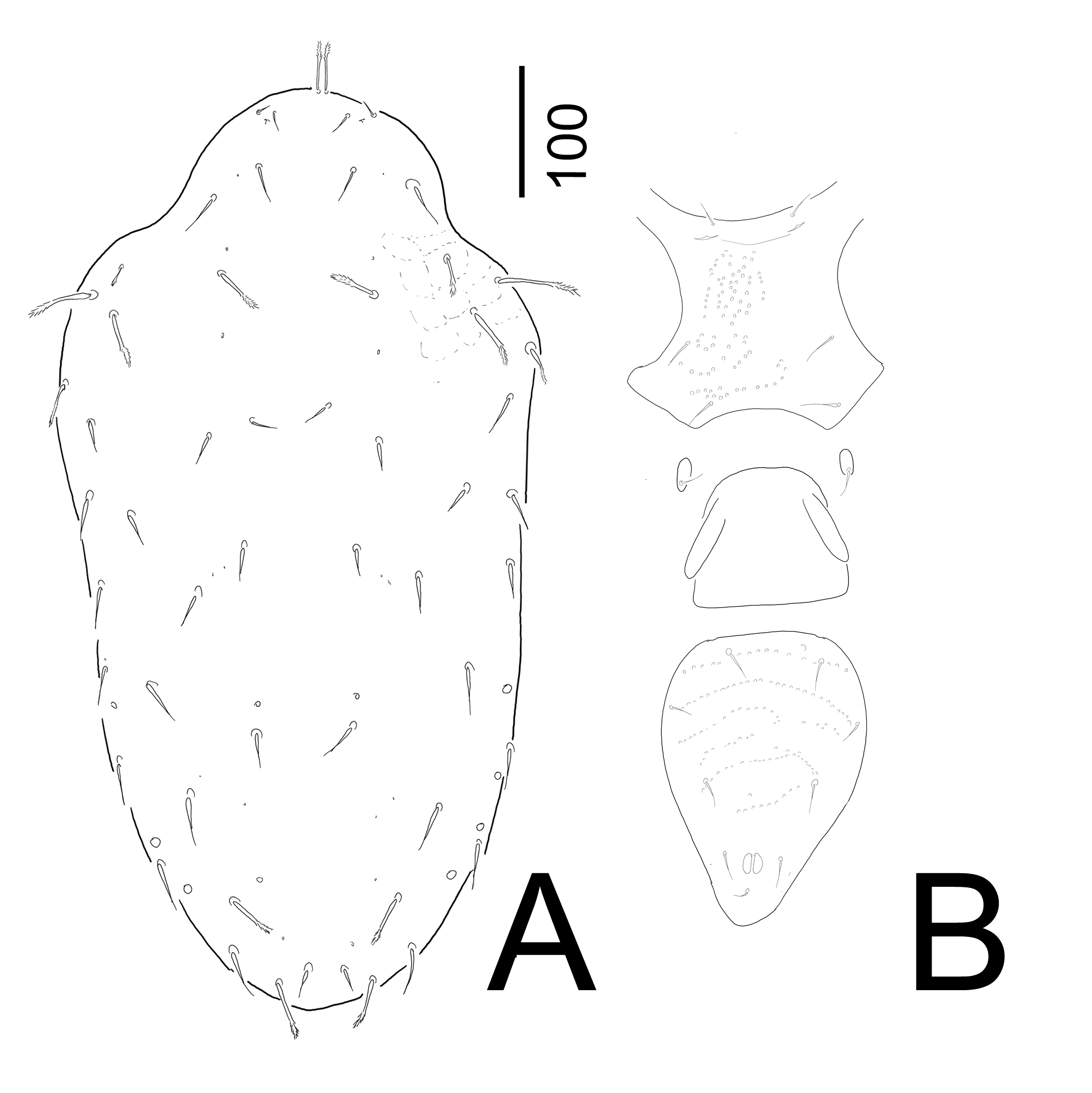First report of Macrocheles robustulus (Berlese, 1904) (Acari: Mesostigmata: Macrochelidae) on the pet beetle, Pachnoda marginata peregrina Kolbe (Coleoptera: Melolontidae: Cetoniinae)
Kontschán, Jenő  1
and Hornok, Sándor
1
and Hornok, Sándor  2
2
1✉ Plant Protection Institute, HUN-REN Centre for Agricultural Research, Budapest, Hungary and Department of Plant Sciences, Albert Kázmér Faculty of Mosonmagyaróvár, Széchenyi István University, Mosonmagyaróvár, Hungary.
2Department of Parasitology and Zoology, University of Veterinary Medicine, Budapest, Hungary and HUN-REN-UVMB Climate Change: New Blood-sucking Parasites and Vector-borne Pathogens Research Group, Hungary.
2025 - Volume: 65 Issue: 3 pages: 717-720
https://doi.org/10.24349/e4n8-l8ikShort note
Keywords
Abstract
Species belonging to the mite family Macrochelidae (Parasitiformes: Mesostigmata) are usually large, fast-moving predators living in soil, leaf litter or decomposing organic matter. The macrochelid mites usually feed on nematodes, eggs and larvae of smaller insects or other mites, and very often can be found in association with certain insect groups (e.g. flies and beetles) (Mašán 2003). The association of macrochelids with flower beetles (Coleoptera: Scarabaeidae: Cetoniinae) seems to be a rare phenomenon and the published records are presented from Europe, North America, South-Africa and Iran. The first report of the association of macrochelid mites and flower beetles was presented by Ryke & Meyer (1958) from Republic of South-Africa. Several years later Haitlinger (2002) mentioned four macrochelid mites in association with two cetoniin beetles (Oxythrea funesta (Poda) and Potosia cuprea metallica (Herbst)). Mašán (2003) in his monograph about the macrochelid mites of Slovakia also presented four species associated with a centoniin species (Potosia cuprea Fabicius). So far only one species [Macrocheles glaber (J. Müller, 1860)] has been reported from Cetonia aurata (Linnaeus) (Ács and Kontschán 2014) and one species from Hoplia hungarica Burmeister (Kontschán 2018) from Hungary. Norton (1973) mentioned two species from Osmoderma eremicola Knoch, and Bahrami et al. (2011) listed four macrochelid species in association with Oxythrea cinctella flower beetle.



A couple of months ago, some photos were presented about the pet cetoniin beetle, Pachnoda marginata peregrina Kolbe (Figure 1A) in a Hungarian Facebook Group (Insects in terrarium, posted by A. Kovács). The presented photos contained some cetoniin beetles with mites on their bodies (Figure 1B). An e-mail was written to the owner of the beetles to request some mites for identification. The investigated mites were cleared in lactic acid for a week and afterwards were studied with a Leica 1000 compound microscope with a drawing tube. Specimens examined are stored in 70% ethanol and deposited in the mite collection of Plant Protection Institute, HUN-REN Centre for Agricultural Research, Martonvásár, Hungary. Measurements are given in micrometers (μm).
Six females of Macrocheles robustulus (Berlese, 1904) (Figures 2) were collected on body of P. marginata pergrina in terrarium of beetles in Ecséd (Hungary).
The dorsal shield of examined M. robustulus is oblong with fine reticulate sculptural pattern. Majority of dorsal setae are smooth, except setae serrate or pilose j4, s2, r2, r3, z4, Z4 and Z5. Setae j1 are brush shaped (Fig 2A). Ventral shields are sculptured. Sternal shield is sparsely punctured to micropunctured. Ventrianal shield is reticulated and punctured in some rows (Fig 2B).



Macrocheles robustulus lives in decaying substrates of organic origin, it prefers dunghills, manures and excrements, often occurs in bird nests and composts (Mašán 2003). This species is also reported in association with scarabaeid insects, like Aphodius subterraneus, Copris lunaris and Potosia cuprea (Mašán 2003). Karg (1993) mentioned from soils of natural habitats and greenhouses, compost and together with enchytreids and from Onthophagus species. This species was reported in Europe, Middle East, North- and South America and Australian regions (Mašán 2003) and it is common in Hungary, earlier it was collected from from dung of horse, cattle and pig and from soil (Kontschán 2020).
This is the first report of Macrocheles robustulus in association with the pet beetle Pachnoda marginata peregrina and this is also the first report of this pet beetle with mites.
Download as
Mite species
Host cetoniinae species
Locality
References
Glyptholaspis americana (Berlese, 1888)
Oxythyrea funesta (Poda)
Poland
Haitlinger 2002
Glyptholaspis confusa (Foá, 1900)
Potosia cuprea (Fabricius)
Slovakia
Mašán 2003
Glyptholaspis saprophila Mašán, 2003
Potosia cuprea (Fabricius)
Slovakia
Mašán 2003
Macrocheles insignitus Berlese, 1918
Potosia cuprea (Fabricius)
Slovakia
Mašán 2003
Potosia cuprea (Fabricius)
Poland
Haitlinger 2002
Oxythyrea funesta (Poda)
Poland
Haitlinger 2002
Oxythrea cinctella (Schaum)
Iran
Bahrami et al. 2011
Macrocheles merdarius (Berlese, 1889)
Potosia cuprea (Fabricius)
Slovakia
Mašán 2003
Oxythrea cinctella (Schaum)
Iran
Bahrami et al. 2011
Macrocheles robustulus (Berlese, 1904)
Potosia cuprea (Fabricius)
Slovakia
Mašán 2003
Pachnoda marginata peregrina Kolbe
Hungary
Present study
Macrocheles glaber (J. Müller, 1860)
Oxythyrea funesta (Poda)
Poland
Haitlinger 2002
Oxythrea cinctella (Schaum)
Iran
Bahrami et al. 2011
Cetonia aurata (Linnaeus)
Hungary
Kontschán & Ács 2014
Macrocheles mamifer Berlese, 1918
Oxythyrea funesta (Poda)
Poland
Haitlinger 2002
Macrocheles kekensis Kontschán, 2018
Hoplia hungarica Burmeister
Hungary
Kontschán 2018
Macrocheles merdarius africanus Ryke & Meyer, 1958
Pachnoda rufa (Des.)
Republic of South-Africa
Ryke & Meyer 1958
Macrocheles scutacus (Berlese, 1904)
Oxythrea cinctella (Schaum)
Iran
Bahrami et al. 2011
Macrocheles sp. near muscaedomesticae
Osmoderma eremicola Knoch
USA
Norton 1973
Macrocheles sp.
Osmoderma eremicola Knoch
USA
Norton 1973
To date, very few macrochelid species have been reported from cetoniin beetles (Table 1.). Contrary to other beetles from the family Scarabaeidae, flower beetles usually feed on pollen from flowers, which are unsuitable habitats for the fast-moving predatory mites like the macrochelids. The dung beetles (Scarabaeinae) and their close relatives (like Geotrupinae) carry several macrochelid mites, and their used habitat (like dungs or compost) has many insects, nematodes, or other prey of the predatory mites. However, the larvae of the flower beetles live in compost or other organic substrates, where the macrochelid mites can join the larvae of flower beetles. After the metamorphosis of the beetle larvae, these mites could stay on the body of the adult flower beetles.
The origin of Pachnoda marginata peregrina is the West Afrotropical realm, where its larvae live in compost and organic substrates, similar to the other larvae of flower beetles. However, the Macrocheles robustulus has not been reported from the West Africa; but this mite occurs in other tropical areas as well (Mašán 2003), so the potential association between the mite and the beetle is also possible in the area of origin of the host beetles as well.
The herein reported association between Macrocheles robustulus and the pet beetle Pachnoda marginata peregrina could, however, easily become established in the microenvironment of a terrarium. Either the bought beetle substrate was infected with the mites or the bought beetle larvae carried the mites on their bodies. Still, these mites were not observed earlier in the terrarium or on the body of larvae, so we need to suppose that these mites were originally present in the substrate and later colonized the terrarium and the beetles.
Macrochellid mites associated with cetoniin beetles
We summarised all information about the association of these two invertebrate groups in Table 1. Most of the published information (nine species) are presented from Europe, but only two macrochelid mites were recorded from North America (Norton 1973), one from South-Africa (Ryke & Meyer 1958) and four species from Iran (Bahrami et al. 2011). The two big comprehensive works (Karg 1993 and Bregetova 1977) did not present any associations macrochelid mites with flower beetles.
References
- Ács A, Kontschán J. 2014. Contribution to the Macrochelidae Vitzthum, 1930 fauna of the Carpathian Basin and the Balkan Peninsula (Acari: Mesostigmata). Opusc. Zool. Budapest, 45(2): 109-118.
- Bahrami F, Arbabi M, Shoushtari VR, Kazemi Sh. 2011. Mesostigmatic mites associated with Coleoptera and biodiversity calculation of these mites phoretic on dung beetles in Golestan Province (North of Iran). Middle-East J. Sci. Res., 9(3): 345-366.
- Berlese A. 1888. Acari Austro-americani quos collegit Aloysius Balzan. Boll. Soc. entomol. ital., 20: 171-222.
- Berlese A. 1889. Acari, Myriopoda et Scorpiones hucusque in Italia reperta, 54.
- Berlese A. 1904. Acari nuovi. Manipulus II. Redia, 1: 258-280. https://doi.org/10.1177/0038026104SP100122
- Berlese A. 1918. Centuria quarta di Acari nuovi. Redia, 13: 115-192.
- Bregetova NG. 1977. [Identification key for soil inhabiting mites. Mesostigmata.] Nauka, Leningrad pp. 717. (in Russian).
- Foà A. 1900. Esistono il polimorfismo e la partenogenesi nei Gamasidi. Boll. Soc. entomol. ital., 32: 121-149.
- Haitlinger R. 2002. Mites (Acarina) associated with Cetoniinae and Trichiinae (Insecta: Coleoptera: Scarabaeidae) in Poland. In. Ignatowicz S. (Ed). Postepy polskiej akarologii. Warsawa: Wydawnictwo SGGW. p. 63-73.
- Karg W. 1993. Acari (Acarina), Milben Parasitiformes (Anactinochaeta) Cohors Gamasina Leach. Raubmilben. Jena, Stuttgart, New York Gustav Fischer Verlag. p. 96-114.
- Kontschán J. 2018. Macrocheles kekensis sp. n., a new macrochelid mite associated with a centoniin beetle from Hungary (Acari, Mesostigmata). ZooKeys, 768: 97-104. https://doi.org/10.3897/zookeys.768.24460
- Kontschán J. 2020. Checklist of the Hungarian species of family Macrochelidae (Acari: Mesostigmata). Acarol. Stud., 2(1): 7-17.
- Mašán P. 2003. Macrochelid Mites of Slovakia (Acari, Mesostigmata, Macrochelidae). Institute of Zoology, Slovak Academy of Sciences, Bratislava. pp. 149.
- Müller J 1860. Die Insektenepizoen mährischen Fauna. Jahresbericht der mährisch-schlesische Gesellschaft, Brünn. p. 157-184.
- Norton R. 1973. Phoretic mites associated with the hermit flower beetle, Osmoderma eremicola Knoch (Coleoptera:Scarabaeidae). Am. Midl. Nat., 90(2): 447-449. https://doi.org/10.2307/2424466
- Ryke PAJ, Meyer MKP. 1958. Some parasitoid mites (Mesostigmata: Acarina) associated with Coleoptera in the Western Transvaal. Journal Ent. Soc. S. Africa., 21(1): 139-161.



2025-04-23
Date accepted:
2025-07-15
Date published:
2025-07-17
Edited by:
Roy, Lise

This work is licensed under a Creative Commons Attribution 4.0 International License
2025 Kontschán, Jenő and Hornok, Sándor
Download the citation
RIS with abstract
(Zotero, Endnote, Reference Manager, ProCite, RefWorks, Mendeley)
RIS without abstract
BIB
(Zotero, BibTeX)
TXT
(PubMed, Txt)



